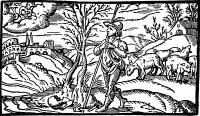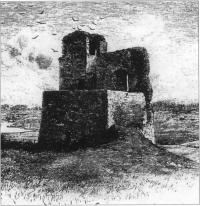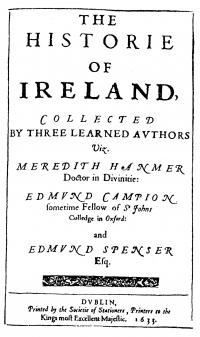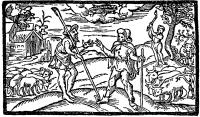Another Case of Censorship? the riddle of Edmund Spenser’s ‘A View of the Present State of Ireland’ (c.1596)
Published in Early Modern History (1500–1700), Features, Issue 2 (Summer 1996), Volume 4
Edmond Spenser(Reproduced by permission of the Masters & Fellows, Pembroke College,Cambridge)
There is a certain sensitivity within the upper echelons of the British establishment when it comes to writing about Ireland. Liz Curtis points out in Ireland: The Propaganda War (1984) that during recent British media coverage of Northern Ireland numerous television programmes, interviews and news items have remained unshown or been delayed because of official intervention. Such censorship is by no means a new phenomenon, but, whilst recent cases are well documented, the further back one goes, the more difficult it becomes to interpret the evidence unequivocally.
Spenser and the literary critics
Edmund Spenser (1552?-1599) is considered by many literary critics as the major poet of the English Renaissance. He was enormously productive in his later adult life, writing a series of poems which changed the course of English literature beyond recognition: a pastoral, The Shepherdes Calendar; the most notable marriage hymn in English, The Epithalamion; and most importantly, the romance-epic The Faerie Queene. Spenser probably came to Ireland in 1580 as secretary to the Lord Deputy Arthur Grey de Wilton, subsequently occupied a series of administrative posts and settled on the Kilcolman estate, County Cork, where he lived for ten years until being forced to flee when the Munster plantation was overrun by Hugh O’Neill’s confederatesin 1598. Spenser died in London soon after, according to Ben Jonson, ‘for lack of bread’.
The influence of Ireland upon Spenser’s imagination has come to be more fully recognised in recent years, as has the importance of his long tract, A View of the Present State of Ireland. In this orchestrated dialogue between the fictional Eudoxus and Irenius, Spenser was highly critical not only of Irish life but also of English government policy and Anglo-Irish magnate behaviour. A View, which was probably composed in 1596, had to wait until 1633 before it entered the world of print, when it was published by the eminent antiquarian, Sir James Ware, alongside the more obviously historical works of Edmund Campion and Meredith Hanmer, in The Historie of Ireland.

‘Januarye’-woodcut from The Shepherdes Calendar, Spenser’s contribution to pastoral poetry. His own Irish idyll was shattered by Nine Years War.
As a result numerous historians and literary critics dealing with the period have assumed that A View must have been singled out for particular hostility by the authorities and censored because it was such an offensive work. Ciarán Brady has claimed that ‘in the radical character of its analysis and in the extremity of its propositions, Spenser’s View was unique’ and ‘was even then, as it has been since, a source of some embarrassment’. Much ink has been spilt trying to explain exactly why A View disturbed readers so much and various answers have been given. Some claim that the work denigrated Elizabeth’s Anglo-Irish allies and thus threatened the crown’s patronage system in Ireland; others that the economic consequences of the proposals were unfeasible but dangerously attractive to the uninitiated; others that when Irenius recommends that Ireland needs a Lord Lieutenant ‘of some of the greatest personages in Englande suche as one I Coulde name uppon whom the ey of all Englande is fixed’, he is referring to Robert Devereux, Second Earl of Essex, soon to be executed after his failed coup d’etat. The question has appealed to literary critics of a post-structuralist bent who have claimed that the tract had to be silenced because it laid bare ‘the premises upon which sovereign power operates’ or ‘as a vehicle for official truth it seemed unstable, and, therefore, threatening’.
A debate has developed between those, like Ciarán Brady, who argue that Spenser’s work was so offensive and extreme that even the English authorities who had a vested interest in suppressing any form of opposition in Ireland could not stomach its proposals and suggestions; and those who follow Nicholas Canny in believing that A View helped foster an Anglo-Irish identity because it was a fitting expression of opinions and convictions commonly held among the New English who, like Spenser, had come to Ireland mainly in the latter half of Elizabeth I’s reign. This debate would be radically altered if it could be shown that A View was not censored. Canny’s argument would gain further plausibility if it turned out that the opinions expressed in A View were nothing more nor less than those generally held among the New English and that the work was unlikely to have attracted the attention of those empowered to prevent the appearance of suspect books in England. Hence, the time has come to re-examine the evidence which has led so many scholars to jump to conclusions.
The printer
On 14 April 1598, the printer Matthew Lowndes entered into the registers of the Company of Stationers of London ‘a booke intitled A viewe of the present state of Ireland. Discoursed by way of a Dialogue betweene EUDOXUS and IRENIUS. uppon Condicion that hee gett further aucthoritie before yt be prynted’. The work was not printed in Spenser’s lifetime, although it circulated widely in manuscript form. No other contemporary evidence exists as to why this should have been the case, so the assumed censorship of the text is no more than a reasonable inference.

Kilcolman Castle,Country Cork – Spenser lived here for ten years until forced to flee when the Munster plantation was overrun by Hugh O’Neill’s confederates in 1598.
Sir James Ware
Ware’s treatment of Spenser’s tract is both fascinating and disturbing. In his preface, Ware is keen to emphasise the use of A View as an ‘ancient Irish history’ rather than a discussion of the contemporary problems of the 1590s and how they could be solved—principally by sending over a large army from England and then establishing a series of permanent garrisons throughout Ireland to defeat and then contain indigenous resistance. In other words, A View is presented to the reader as a piece of antiquarianism rather than possibly relevant political advice, despite the fact that the speakers in the dialogue itself agree to limit their consideration of ancient Irish customs and culture and deal with them on another occasion (no evidence survives of this proposed text).
Ware is explicitly critical of some of Spenser’s opinions, perhaps betraying a nervousness that some might take offence at the comments made, and clearly felt the need to defend his decision to publish the work:
As for his [Spenser’s] work now published, although it sufficiently testifieth his learning and deepe judgement, yet we may wish that in some passages it had bin tempered with more moderation. The troubles and miseries of the time when he wrote it, doe partly excuse him, And surely wee may conceive, that if hee had lived to see these times, and the good effects which the last 30 yeares peace have produced in this land, both for obedience to the lawes, as also in traffique, husbandry, civility, and learning, he would have omitted those passages which may seeme to lay either any particular aspersion upon some families, or generall upon the Nation.
In order to facilitate this alteration of historical perspective, Ware accordingly removed a number of passages. These range from relatively simple changes, omitting words such as ‘barbarous’ and ‘savage’ when used to describe the Irish, to the cutting of longer passages specifically criticising Anglo-Irish magnates like the De Courcys, Roches and the Bremingtons for ‘degenerating’, and becoming Irish, as well as some of Spenser’s harsher anti-Catholic rhetoric.
Ware’s seems intent on sanitising A View, rendering it less offensive both to certain powerful individuals and more general Irish readers. The reader is invited to regard the work as part of a dead historical tradition which may be of interest, but is unable to influence contemporary Anglo-Irish relations, an aim which appears to be somewhat at odds with the original intention of the tract. That Ware’s anxiety was focused principally on A View rather than the writings of Campion, Hanmer and the brief narrative of Marleborough, who continued Hanmer’s history, would seem to be confirmed by his prefatory comments which centre on that text. It is not known why Ware chose to publish A View, but it might well have had something to do with Spenser’s burgeoning reputation in the early seventeenth century, especially amongst Protestant readers, and the fact that it clearly circulated in manuscript as over twenty copies survive.
Assumptions
Such evidence would seem to confirm that it is a reasonable inference to assume that A View was censored. Certainly, Ware’s editorial policy suggests that the work had a certain notoriety in the early seventeenth century before it was even printed. The entry in the Stationers’ Register would seem to provide further support for this conclusion. Entries in the register can be divided up into three types: those which grant licence to the printer who has submitted the work on the payment of a fee; those which demand that the printer needs to discover whether anyone else has rights to the work in question; and those which demand that the printer seek further permission before the work can be published. The smallest category of these three by far is the third one, although a number of examples can be cited from the late 1590s.
The Stationers’ Register
What function did the Stationers’ Register serve? The purpose of entering books into the register was not primarily to have them checked by the censors; rather, it was to register them as the property of the individual printer, in other words, the register operated as an early form of copyright law. The need for Matthew Lowndes to obtain ‘further aucthoritie’ before he could publish A View does not necessarily mean that the text was put aside for state censors to examine further; there might well have been other reasons for its non-appearance. There is no clear evidence as there is for the suppression of Samuel Harsnett’s attempt to publish John Hayward’s Henry IV, perhaps the most infamous case of Tudor censorship.
Books did indeed fail to appear for other reasons. It is not beyond the bounds of possibility that A View was not published simply because its author died before the text was ready for publication. Spenser died on 13 January 1599 and, given his close involvement with William Ponsonby in seeing both editions of The Faerie Queene and his other poetical works through the press, there might not have been enough time for the preparation of a carefully produced manuscript, especially given Spenser’s attempts to control the production of his work (unusual by early modern standards) and his permanent residence in south-west Ireland.
A much more likely explanation is that A View failed to appear because of a serious disagreement between members of the Stationers’ Company as to who had rights to publish Spenser’s works. Matthew Lowndes was involved in a series of disputes with the more powerful William Ponsonby, who was about to become a master warden of the company, over rights to publish the works of both Spenser and Sir Philip Sidney. Ponsonby had publicly stated his co-operation with Spenser in ‘The Printer to the Gentle Reader’ which prefaced the 1591 publication of Spenser’s Complaints. In the same text he wrote of his attempt to trace the manuscripts of some of the poet’s ‘smale Poemes’, which he had ‘heard were disperst abroad in sundrie hands…some of them having bene diverslie imbeziled and purloyned from him [Spenser], since his departure over Sea’. Ponsonby was understandably concerned that none of Spenser’s—or Sidney’s—texts should fall into unauthorised hands.
Lowndes’ attempt to have A View published would appear to be an act of literary poaching. It is possible that one of the extant manuscripts in circulation fell into Lowndes’ hands, with or without the author’s knowledge or permission, and Lowndes attempted to make some money on the back of Spenser’s reputation. Ponsonby would presumably have been less than delighted at the prospect of another stationer laying claim to one of his major authors, especially given the fact that Lowndes had already had an unauthorised edition of Sidney’s Astrophil and Stella published in 1597, a year ahead of Ponsonby’s official edition. A View might well have been the victim of a powerful publisher’s ire at an attempt to pirate an edition and by 1598 Ponsonby was almost certainly in a position to hinder Lowndes’ pursuit of a licence.

Title-page of Ware’s The Historie of Ireland(1633)
Possible reasons for censorship
If A View was proscribed on the other hand, it could have been censored for any number of reasons. Possibly for simply dealing with Irish affairs, or even, for mentioning Ireland in its title, as we have no reason to assume that official censors then were any more assiduous and careful readers than they are now. It should be further borne in mind that the text was submitted in 1598, a particularly sensitive year, when there seemed a real chance that Hugh O’Neill’s revolt would succeed. The sacking of the Munster plantation later that year saw many unpublished tracts explaining the disaster and suggesting solutions to Elizabeth’s Irish problem (including another possibly by Spenser); but these remain among the State Papers and none was entered into the Stationers’ Register to be considered for publication.
The only tract published which compares to A View in the depth and breadth of its political analysis is Richard Beacon’s Solon his Follie (1594)—William Herbert’s Latin tract, Croftus sive de Hibernia liber (c.1591) may well have been prepared for publication, as the careful state of the manuscript suggests, but it was not entered into the register and did not appear in print. Beacon’s work, by a government employee in Munster, may have escaped official ire because it appeared at a less critical time than A View, was a disguised allegory which made more generalised proposals and, more likely, because it was published in Oxford rather than London. The Royal Charters which established the monopoly of printing for the Stationers’ Company in 1557 and 1559 allowed the presses set up in Oxford and Cambridge to remain outside the jurisdiction of the Company and free from its injunctions. Whilst books published in London (i.e. virtually all books) had to be licensed by approved authorities (after 1586 these were the Archbishop of Canterbury and the Bishop of London), those published in Oxford did not. If the heavy hand of the censor was operative, it is probably the case that Solon his Follie, a work which betrays no Irish connection until opened, escaped censorship by default, having been published, quite deliberately, through the back door.

‘Februarie’ – The Shepherdes Calendar.
Severity of A View not unique
How much did A View differ from other treatises written in the 1590s? The answer is not greatly, although it is more substantial and carefully argued than many. Spenser’s argument is quite simple in essence despite its complex form and develops logically. The Irish, it is claimed, are hopelessly savage in their customs and pose a threat to civilised society. Their way of life marks them out as Scythian, the notorious barbarians of the ancient world. They have infected the original Anglo-Norman colonists with their customs and habits so that they have ‘degenerated’ and become Irish rather than English. Regrettably, the state of affairs in Ireland is so dire that reform using the legal and institutional apparatuses available is not a viable option. Instead, a huge army must be sent over and Ireland reconquered before any such reform take place. Fundamentally, the message is that one has to be cruel to be kind.
Brady’s argument that A View is unique is questionable. Calls for substantially more military assistance from England were common among the letters deposited in the State Papers, although few matched the detail in Spenser’s plans. The same is true of Spenser’s demand that Ireland be reduced to famine by a scorched-earth policy of destroying crops. This was a routine operation by English military commanders and frequently commented upon with approval by English writers. Such a policy was instrumental in helping Lord Mountjoy eventually win the Nine Years War and crush the resistance of Hugh O’Neill after Spenser’s death. The belief that the Irish were Scythian was a commonplace among English writers, as was the notion that Irish society would cause the English to ‘degenerate’ into Irishness unless controlled and transformed. Much that Spenser writes concerning Irish character is an elaboration of the chauvinistic writings of Gerald of Wales, the Anglo-Norman author, whose observations were regularly repeated by later English commentators.
Other substantial tracts written in the late 1580s and early 1590s, such as Herbert’s Croftus sive de Hibernia liber and Beacon’s Solon his Follie, contained similarly harsh recommendations. Both made a strong case for the need to extensively colonise Ireland as a means of extirpating Irish culture; both regarded the Irish as savage barbarians; both envisaged the need for invasion if all else failed and described the severe military operations necessary (including the introduction of famine); both relied to a large extent on Gerald of Wales and discussed the problem of ‘degeneration’ at length.
Some conclusions
The evidence as it stands would seem to indicate that A View failed to appear for a variety of local difficulties rather than as a consequence of a conspiracy to suppress the work because it was particularly offensive or dangerous. There is no direct evidence at all that it was censored or that anyone in authority worried about the work. The only case for censorship that can be made on the evidence available is that virtually no other texts were entered into the Stationers’ Register or published in the whole of the Elizabethan period which dealt with Ireland, apart from a few ballads, news books and broadsides, and a long illustrated poem by John Derricke, The Image of Ireland (1581). The small number of texts published might mean that the government was keen to suppress anything that mentioned Ireland in any detail, or referred to the country in the title. If so, A View would fall into this category.
However, this is no more than an inference. The motives behind Matthew Lowndes’ attempt to publish A View remain a mystery as it appears to be a text more suited for manuscript circulation than publication, as a number of surviving manuscripts suggests. As such, its rhetoric was probably intended to persuade those in high places of the use of its proposals rather than a wider public. There is little in common between the rigorous discussion of policy in A View and the collection of impressionistic prejudices trotted out in the works of Barnaby Rich, Thomas Churchyard and John Derricke.
If A View was not actually censored and its appearance in the Stationers’ Register was no more than an anomaly, then the terms of the debate surrounding the text and Spenser’s role in Elizabethan Ireland will have to shift. It will no longer be possible for critics to cite a supposed historical fact in order to argue that A View was different from all other works. Such arguments will have to rely on textual analysis and comparison. Opinion will shift towards an understanding of the work as a forceful and eloquent expression of the ideological position of the New English, one which played a crucial role in the establishment of their subsequent identity.
Andrew Hadfield is senior lecturer in English at the University of Wales, Aberystwyth.
Further reading:
C. Brady, ‘Spenser’s Irish Crisis: Humanism and Experience in the 1590s’, Past and Present 111 (1986).
N. Canny, ‘Edmund Spenser and the development of Anglo-Irish identity’, The Yearbook of English Studies, 13 (1983).
P. Coughlan, Spenser and Ireland: an interdisciplinary approach (Cork 1989).
C. Hill, ‘Censorship and English Literature’, in The Collected Essays of Christopher Hill, Vol. I (Brighton 1985).
An earlier version of this article appeared in Notes and Queries 239 (1994).
















